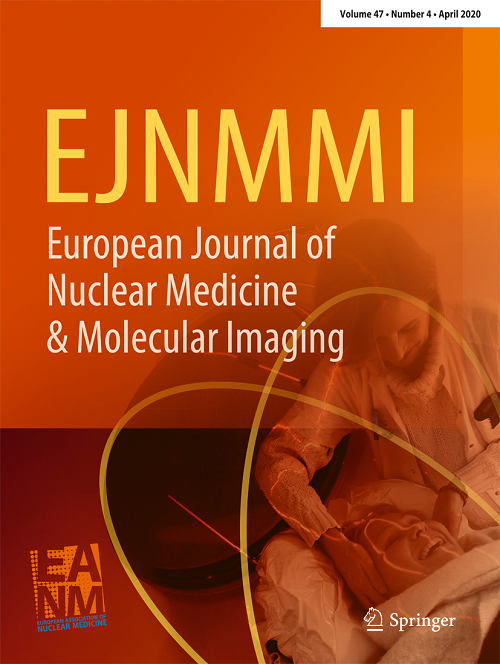Visual interpretation of [18F]Florzolotau Tau-PET imaging for differentiating alzheimer's disease and progressive supranuclear palsy.
IF 7.6
1区 医学
Q1 RADIOLOGY, NUCLEAR MEDICINE & MEDICAL IMAGING
European Journal of Nuclear Medicine and Molecular Imaging
Pub Date : 2025-10-01
DOI:10.1007/s00259-025-07539-x
引用次数: 0
Abstract
INTRODUCTION Tau accumulation in the brain is a hallmark of both Alzheimer's disease (AD) and progressive supranuclear palsy (PSP), complicating differential diagnosis. The novel [18F]Florzolotau tauPET enables invivo detection. This study tests a visual reading approach on [18F]Florzolotau PET for reliably separating AD from PSP and assessing its clinical usefulness. METHODS Eightynine participants of Aβpositive AD, Aβnegative PSP, and cognitively unimpaired controls (CU) underwent [18F]Florzolotau PET, [18F]Florbetapir amyloidPET, and MRI. Visual interpretation of the tau-PET scans was performed using a colormap-based method, dividing the brain into AD-specific regions and PSP-specific regions. Regional tau uptake was scored visually, and the results were compared with SUVr values from quantitative analysis. Decision tree analysis was used to classify patients based on visual scores. RESULTS The study found significant differences in visual scores between the CU, AD, and PSP groups, particularly in the AD-specific and PSP-specific regions. Visual assessment of tau uptake moderately correlated with SUVr values, especially in AD-specific regions. The decision tree model using visual scores accurately classified CU, AD, and PSP patients, with sensitivity and specificity rates exceeding 85%. Interobserver agreement for visual scoring was high, supporting the reliability of this method in clinical settings. CONCLUSION Visual interpretation scoring system of [18F] Florzolotau tau-PET reliably distinguishes AD from PSP, shows strong correlations with diagnoses, and is simpler than quantitative analyses for routine practice. Larger cohorts must confirm accuracy, refine the method, and assess its ability to grade disease severity.[18F]Florzolotau Tau-PET成像鉴别阿尔茨海默病与进行性核上性麻痹的视觉解释。
tau蛋白在大脑中的积累是阿尔茨海默病(AD)和进行性核上性麻痹(PSP)的标志,使鉴别诊断复杂化。新型[18F]Florzolotau tauPET可实现体内检测。本研究测试了[18F]Florzolotau PET的视觉阅读方法,用于可靠地分离AD和PSP,并评估其临床实用性。方法89例a β阳性AD、a β阴性PSP和认知功能正常对照组(CU)接受[18F]Florzolotau PET、[18F]Florbetapir淀粉样蛋白PET和MRI检查。使用基于颜色图的方法对tau-PET扫描进行视觉解释,将大脑分为ad特异性区域和psp特异性区域。对区域tau摄取进行视觉评分,并将结果与定量分析的SUVr值进行比较。采用决策树分析法根据视觉评分对患者进行分类。结果研究发现,CU组、AD组和PSP组的视觉评分存在显著差异,尤其是AD特异性和PSP特异性区域。视觉评估tau摄取与SUVr值中度相关,特别是在ad特异性区域。采用视觉评分的决策树模型对CU、AD和PSP患者进行了准确分类,敏感性和特异性均超过85%。观察者之间对视觉评分的一致性很高,支持该方法在临床环境中的可靠性。结论[18F] Florzolotau tau-PET视觉判读评分系统能可靠地区分AD和PSP,与诊断有较强的相关性,且比常规实践中的定量分析更简单。更大的队列必须确认准确性,改进方法,并评估其分级疾病严重程度的能力。
本文章由计算机程序翻译,如有差异,请以英文原文为准。
求助全文
约1分钟内获得全文
求助全文
来源期刊
CiteScore
15.60
自引率
9.90%
发文量
392
审稿时长
3 months
期刊介绍:
The European Journal of Nuclear Medicine and Molecular Imaging serves as a platform for the exchange of clinical and scientific information within nuclear medicine and related professions. It welcomes international submissions from professionals involved in the functional, metabolic, and molecular investigation of diseases. The journal's coverage spans physics, dosimetry, radiation biology, radiochemistry, and pharmacy, providing high-quality peer review by experts in the field. Known for highly cited and downloaded articles, it ensures global visibility for research work and is part of the EJNMMI journal family.

 求助内容:
求助内容: 应助结果提醒方式:
应助结果提醒方式:


